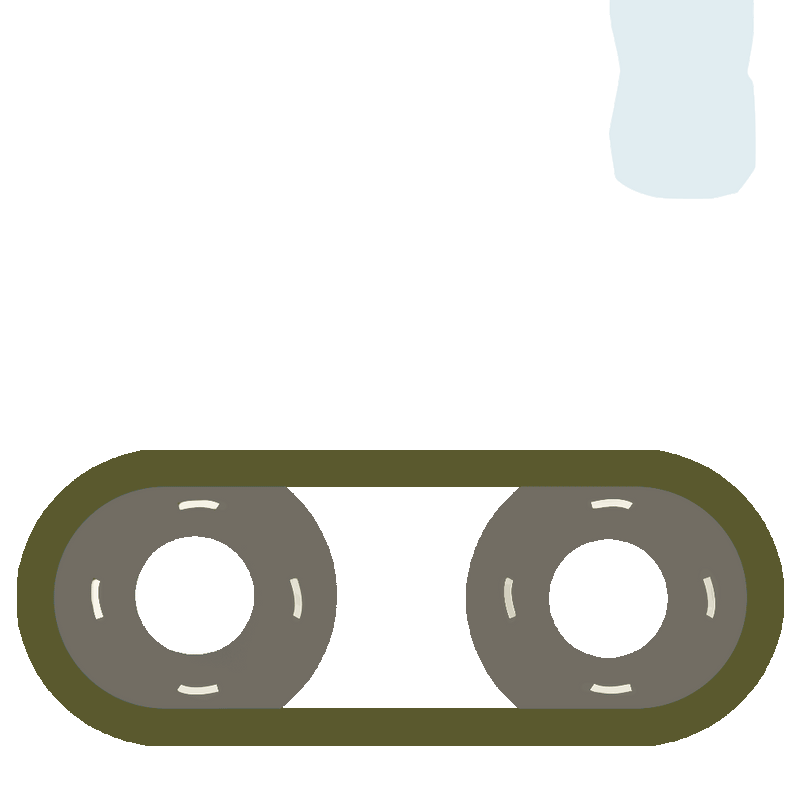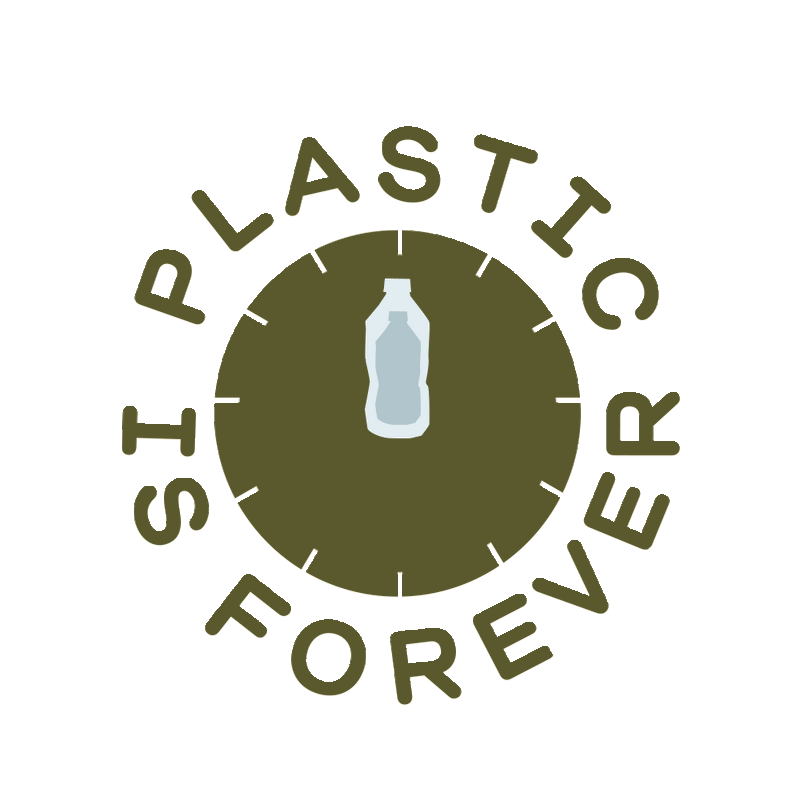

It makes us sick, too.
In a single week,
the average person ingests a credit card’s worth of plastic.
It’s in the air we breathe.
The food we eat.
The drinks we drink.
We know it has a cost, but most of us prefer not to talk about it or even think about it.
It’s time to throw some stones…
Yes, even at ourselves.

The beverage industry manufactures over 580 billion PET bottles per year. Packaging is the number one use of plastic worldwide.
We’ve all heard of carbon footprints, but what about chemical footprints? PET (polyethylene terephthalate) bottles are made out of oil, gas, and an alphabet soup of toxic chemicals, including known carcinogens, which cause harm at every stage of the bottle’s lifecycle, from production to disposal.
Most PET plastic bottles are made from non-renewable petrochemicals like crude oil and fossil gas. The manufacturing of PET released 200 million pounds of toxic, carcinogenic chemicals into the air, water, and land in North America in 2021 alone. PET production in North America emits as much greenhouse gas each year as two million cars.
PET bottles contain hundreds of chemical compounds. A recent scientific review evaluated 300 of these chemicals, and found that at least half of them migrate from packaging into food and beverages, and then into consumers’ bodies. One such chemical, antimony trioxide, is known to cause cancer and to have toxic effects on certain organs including the liver.
More than 70% of PET plastic in North America ends up in landfills, is incinerated (releasing toxic chemicals, such as chlorinated dioxins, into the air we breathe), or becomes litter. Whichever its path, it continues to leach toxic chemicals and heavy metals into the land, air, and water, concentrates toxic organic pollutants, and breaks down into microplastic and eventually nanoplastic particles.
To dive deeper into the chemical footprint of everyday plastics, check out this groundbreaking report from Defend Our Health.

An ever-expanding body of research is shedding light on the implications of humankind's relationship with plastics. We are beginning to understand how much plastic waste is building up, how long it lasts, and how much harm it is causing.
300 million tonnes of plastic is produced every year — an amount equivalent to the weight of the entire human population. Plastic production is expected to nearly triple by 2060. As the demand for fossil fuels drops, petrochemicals continue to be cheap. This solidifies the use of virgin plastic as the go-to option for products from packaging to clothing.
Virgin plastic is cheaper than recycled plastic. Less than 10% of the plastic created since the 1950s has been recycled. Most plastic can only be “downcycled,” or made into a lower grade version of itself, and usually only once. Also, studies have shown that recycling of PET plastic bottles can lead to the formation of cancer-causing chemicals like benzene and styrene that leach into the beverages they house.
It takes approximately 500 years for a PET plastic bottle to fully decompose. The components of plastic break down into microplastic, and then into nanoplastic: invisible, airborne plastic dust that we inhale, eat, and drink. Microplastic particles have been found atop Mount Everest, at the bottom of the Mariana Trench, in the human bloodstream, in breastmilk, and pretty much everywhere.
At least 32% percent of plastic ends up in our oceans, where it poisons aquatic life and destroys ecosystems. Plastic is expected to outweigh fish in the sea by 2050. Ingestion of plastic kills an estimated 1 million marine birds and 100,000 marine animals each year.
Follow up-to-date journalism on the plastic pollution crisis in our Newsroom lower down on this page, where our team is curating recommended reading to keep you in the loop.
(Where we shine and where we need to grow)
We are currently using 1,537 kgs of plastic per year for packaging in our stores for smoothies etc. There are “compostable” alternatives, but they are lined with plastic and thus cannot biodegrade or be recycled, although we so often see them "wishcycled." Until we find a plastic-free solution, please bring a reusable cup and receive 50 cents off your smoothie.
We are currently using 1,140 kgs of plastic per year in ice packs for our delivery program. They are reusable and returnable. You have two options:
A - Keep them. Reuse them.
B - Leave them on your doorstep at the time of your next delivery, and we’ll pick them up and reuse them ourselves.
We use 2,368 kgs of plastic per year in pallet stretch wrap and 5,590 kgs in miscellaneous production supplies (!?). Yup, that’s a lot of (plastic) baggage. We are working on a paper alternative to the stretch wrap and waste reduction in production supplies. Stay tuned here for updates.
Our carbon footprint needs more work. In 2022, Greenhouse’s operations emitted 6,008 metric tons of CO2, with our largest contributors being bottle production and freight at 18% and 12% of the whole respectively.
Some companies that bottle in plastic cite the carbon footprint of glass as their reason. It is true that making and shipping glass is carbon intensive. To say that makes it more damaging to the planet than single-use plastic bottles, with all their toxic externalities, is false. (But understandable: plastic is far cheaper than glass–it is healthy for margins, if not for humans or the environment.)
While we carbon offset all of our home deliveries, a bigger rock to shift will be reducing the carbon footprint of our glass bottles through local glass production (which requires scale) and reuse (for which we need your help).
At this time, our bottles are made overseas, and while over 60% of their components are recycled, the long journey is carbon intensive (although they are delivered by ship and rail, which are 10X and 6X more efficient that trucking).
We aim to source domestically by 2026. Considerable scale (7-8M units/year per bottle style) is required to meet the minimum order requirements of North American glass producers. With your continued patronage, we will get there.
To further reduce the carbon footprint of our packaging, and to get back to the closed-loop bottle return system we implemented before going national, read our Vision for Reuse.
As mentioned, we believe CPG companies should measure both their chemical and carbon footprints. On the chemical side, from keeping plastic to a minimum to being certified organic, the aforementioned stains notwithstanding, we are proud of our commitments and of the progress we are making.
Glass is the only widely-used packaging material classified as “GRAS” or “generally recognized as safe” by the U.S. FDA. Since our founding in 2014, we’ve bottled in reusable glass. Glass is made from sand, not from petrochemicals. It is not porous like plastic, and it does not leach into the contents of the bottle or the body of the consumer.
Our labels are made from 100% post-consumer waste paper. As of 2023 they are 100% plastic-free. Have you noticed that if you get the label wet it starts to wrinkle? That’s how you know. No more plastic. And they are 100% recyclable.
The most recent step has been switching our caps from plastic to aluminum, making our packaging 99% plastic free. The last 1% is the lining inside our new aluminum caps. This seemingly small change will lead to an annual savings of more than 100,000 kg in plastic pollution alone.
For every kg of plastic we currently use, we remove the same amount of plastic from the environment. We are now Certified Plastic Neutral by rePurpose, the world's leading Plastic Action Platform, dedicated to combating the plastic pollution crisis; so far it has recovered 38,244,358 pounds of nature-bound plastic.
Our 900ml multi-serve juice cartons are made with FSC-certified
paper and have a 71% smaller carbon footprint + 87% less plastic than PET bottles.
Plus, they’re lined with 100% sustainably sourced sugarcane. Shop Now!
At Greenhouse, our dedication to a sustainable future is both deeply rooted and actionable. Over the next five years, we're building a plan to transition 15% of our bottled volume to reused glass bottles. We recognize that while glass recycling has its place (as mentioned above, over 60% of the material in our bottles today is recycled), reuse stands out as the most impactful solution, minimizing raw material usage and significantly reducing our environmental footprint.
To realize this vision, we need collective action. By signing our letter, you're not just supporting Greenhouse, you're showing retailers and distributors that demand exists for a closed-loop, circular economy. This transition requires their infrastructure and commitment. Your signature demonstrates that consumers are ready and eager for change. Together, let's champion a new, sustainable standard for the industry.
In tandem, we're rolling out larger format beverages, which will greatly reduce overall packaging waste.
Follow our journey to become the continent’s most sustainable beverage company, or give us your thoughts on how we can do better. We’re all in this together, and we want to hear from you.
Don’t bother with plastic bags for produce at the grocery store; you’re going to wash those veggies anyway, right? Trade plastic wrap for reusable food wraps or containers; reuse the heck out of your ziplocks, and make an effort to buy in bulk to reduce plastic packaging. Also, don’t forget to support brands who are on a mission to eliminate plastic. 😉
Ever heard of Plogging?! It’s jogging with a wastebag and picking up the litter you see en route. What’s better than crushing kilometers and doing good at the same time?! Never miss an opportunity to pick up plastic trash in your parks and neighborhoods – engage your kids, your friends, and your community in a wholesome for-good activity!
Keep a water bottle, coffee thermos, and reusable bags handy at all times. Use them. Get discounts. Drink less microplastic with your coffee. Feel better. There is an increasing number of local zero-waste shopping options. Hop on google to find a spot near you!
Check your local recycling guidelines, and follow them to a T. Do your darndest to separate and clean your plastics before recycling. It’s important to note that not all plastics are recyclable, so be aware of which ones your local facility accepts.
Choose natural fiber clothing – synthetic fabrics like polyester release more microplastics every time they’re washed – and consider a washing machine filter to trap microplastics. Avoid hygiene products with microbeads, as the tiny plastic particles used in exfoliating body washes and toothpastes enter water systems and harm marine life. Look for products with natural exfoliants instead.
The Scientist / May 2023
Small plastic particulates can induce inflammatory responses in the gut and brain, but removing them reverses this damage.
EuroNews / November 2022
The COP27 sponsor's products were the most commonly found items by volunteers researching plastic pollution.
The Scientist / March 2023
The winding trail of environmental microplastics is leading researchers to the human digestive ecosystem.
Have feedback or ideas?
Get in touch with us.
Get updates on our journey to become the most sustainable beverage company in North America.

































